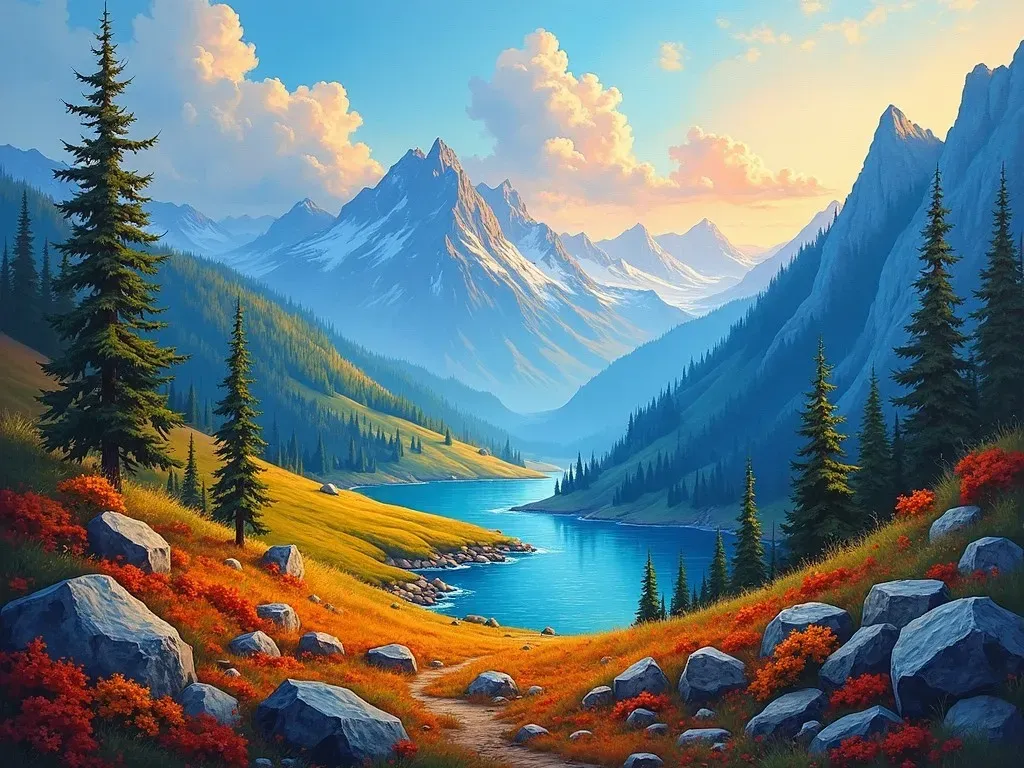Keyword: Painting on landscape
Painting on landscapes combines elements of artistry and nature, inviting artists of all levels to capture the breathtaking beauty of their surroundings. This genre of art encompasses a variety of Techniques and media, ranging from oil to acrylic paints, allowing for personal expression and exploration of color landscapes.
The Essentials of Landscape Painting
Creating stunning landscape paintings begins with understanding the foundational elements of art. Here’s a concise breakdown of the essentials:
Supplies You’ll Need
- Paints: Oil or acrylic paints are popular choices for landscape painting.
- Brushes: A variety of sizes, including flat and round brushes.
- Canvas or Paper: Choose a size that suits your vision.
- Palette: For mixing colors.
- Easels: To hold your canvas steady while you work.
- Palette Knives: Useful for mixing paints or applying thick layers.
| Material | Purpose |
|---|---|
| Oil Paints | Rich colors and blending capabilities |
| Acrylic Paints | Fast-drying and versatile |
| Brushes | For application and detail work |
| Palette | Mixing colors for desired hues |
| Canvas/Paper | The surface for creating your artwork |
| Easels | Provides stability while painting |
Techniques for Painting Landscapes
1. Underpainting
Begin with an underpainting to establish a base tone and help you visualize your composition better. This aids in reducing the starkness of the white canvas.
2. Sketching the Composition
Before applying paint, sketch your landscape lightly with a pencil to outline the main elements. Pay attention to perspective and proportions.
3. Blocking in Colors
Use broad strokes to apply the main colors of your landscape. This stage focuses on the light and dark areas to create depth. Remember to start with the background, typically the sky or distant mountains.
4. Adding Details
Once the base layer is dry, you can introduce more details with smaller brushes. This is where textures come to life, imbuing your painting with realism or abstract qualities, depending on your style preferences.
Reference Video
Tips for Color Landscape Painting
Utilize Color Harmony
Color harmony creates a cohesive look. Use complementary colors to make your focal points stand out. Experiment with warm and cool colors to evoke different moods.
Creating Depth with Atmospheric Perspective
In landscape painting, the technique of atmospheric perspective helps convey distance. Invoking lighter, desaturated colors for distant elements simulates the effect of haze.
Capturing Textures
Using a palette knife or thick brush strokes, you can portray natural textures like rocky mountains or smooth water surfaces. This tactile approach adds dimension to your piece.
Popular Landscape Painting Techniques
Wet-On-Wet
This technique involves applying wet paint onto wet paint, allowing colors to blend beautifully, perfect for capturing skies and water reflections.
Glazing
Glazing refers to applying a thin, transparent layer of paint over a dried layer. This method enhances depth and luminosity in the landscape.
Impasto
In this technique, paint is laid on the canvas very thickly, often creating a three-dimensional effect. Ideal for creating dramatic landscapes featuring foliage or rocky surfaces.
| Technique | Description |
|---|---|
| Wet-On-Wet | Blending wet paint for soft transitions |
| Glazing | Transparent layers for enhanced depth |
| Impasto | Thick application of paint for texture |
Painting on Location vs. Studio
Plein Air Painting
Painting on location, known as plein air painting, allows artists to capture the true essence of a landscape directly from nature. The experience of observing the changing light and atmosphere can significantly influence your work.
Studio Painting
Conversely, studio painting provides the freedom to experiment without environmental interruptions. Artists can work from photos or sketches, merging Inspiration with their creativity over time.
Noteworthy Landscape Artists
Many artists have made significant contributions to landscape painting:
| Artist | Contribution |
|---|---|
| claude monet | Known for his Impressionist landscapes |
| Vincent van Gogh | Blended colors to enhance emotional expression |
| John Constable | Captured the English countryside beautifully |
| Georgia O’Keeffe | Famous for her stylized, vibrant landscapes |
FAQ
Q: What are the best colors to use for landscape painting?
A: Earth tones often work well, including greens, blues, and neutrals. Experimenting with a limited palette can yield harmonious results.
Q: Do I need to paint outdoors to create landscapes?
A: Not necessarily. Many artists create beautiful landscapes using reference photos taken outdoors, allowing for flexibility and creativity in a studio setting.
Q: What beginners’ tips can help me in landscape painting?
A: Start with a simple composition, use a limited color palette, and practice using different brush techniques for creating texture and depth.
Q: Where can I find video tutorials for landscape painting?
A: Websites like Canvasy provide step-by-step tutorials for beginners looking to improve their skills. You can explore various methods and techniques to enhance your landscape paintings.
For reference and further guidance, you can visit Draw Paint Academy for a comprehensive collection of landscape painting tips.
Final Thoughts
Creating captivating landscape paintings is a journey of technique, observation, and personal expression. By understanding the basics, experimenting with various methods, and utilizing the advice of masters, artists can transform their visions into breathtaking works of art. Dive into the world of landscape painting, and let nature inspire your creativity!
